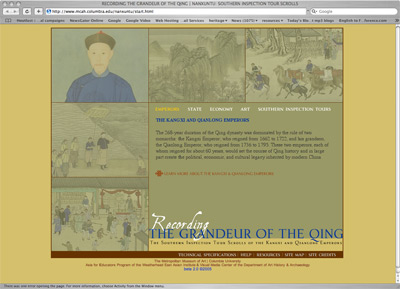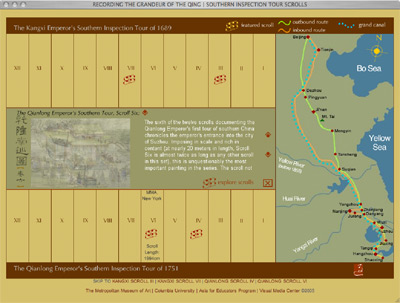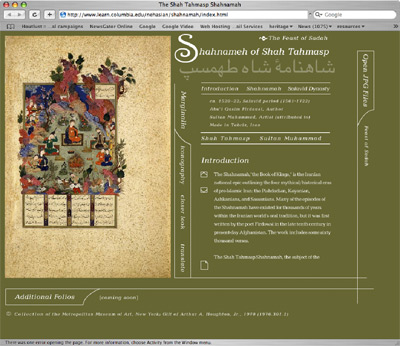
About The Project
Rationale
The visual and material culture of Asia's pre-modern era include objects that do not easily parallel traditional western styles, forms, and media. With this in mind, it was our assertion that the instruction of these subjects would benefit from the creative application of digital technology as applied within framework of the undergraduate curriculum of the Department of Art History and Archaeology. Experimentation with design strategies and new media within this educational context has been the primary guide to the innovation and application of media we have used. In particular, the core curriculum has been our test bed, specifically larger survey courses in South Asian and East Asian art. In some cases, our experiences working through the curriculum mirrored our expectations as articulated in the original proposal. In others, working closely with instructors altered our expectations, even redirecting our attention to material we did not expect to use.
We also recognize that a significant audience will experience our materials as a complement to museum and gallery visits. It has always been our intention to work closely with our partners in the Metropolitan Museum of Art and other institutions from around the world. This relationship has helped produce two of the modules listed below—the Grandeur of the Qing and the Feast of Sadah—with the aim of providing historical and iconographic information to visitors.
Design Principles
There was no overarching design principle that we sought to employ across projects, though several considerations came up time and time again. For example, It has been our experience that modularity—the quality of a system where it consists of various separate units able to function on their own or in concert with other elements—is an important property of successful design. While all of our projects consist of several multimedia elements, each of these elements is available as a standalone resource in the case a faculty member does not need to use the larger program.
It is also worth noting that we consistently attempted to strike a balance in our design aesthetic between creatively representing the style, form, color etc. of the original work while steering clear of simple, even stereotypical, imitation. The opportunity of employing an aesthetic as a pedagogical device in itself has been a worthwhile exploration. But it is easy to spiral into rote imitation, especially when engaging complex materials that may be unfamiliar. Much of our work attempts to strike this aesthetic balance.
Representative Modules
1. The Grandeur of the Qing
The Grandeur of the Qing offers a detailed visual and historical exploration of four monumental scrolls recording the imperial inspection the Kangxi and Qianlong
emperors in the 17th and 18th centuries. Maxwell K. Hearn, Douglas Dillon Curator of Chinese Painting and Calligraphy at the Metropolitan Museum of Art and Madeleine Zelin, professor of modern Chinese history and director of the East Asian National Resource Center at Columbia University, provided the rich scholarly commentary. It was through Professor Hearn efforts that we acquired the outstanding digital images that distinguish this project.
The centerpiece of the Granduer of the Qing is a presentation of four monumental scrolls representing imperial inspection tours. In the beta version of our portal site, you may enter the full program, complete with all commentary and supporting material, or open the scrolls individually to examine each painting. The full site is intended as a rich lesson in the art, culture and history of the period guided by the expertise of scholars. Access to the individual scrolls is intended for classroom presentation or student study focuses on each painting as individual works of art with minimum selected commentary.
2. Exploring Chinese Painting: A Module for Undergraduate Study
The Exploring Chinese Painting Program begins with a workspace allowing students to view and compare a group of important Chinese handscrolls and hanging scrolls from the 10th to the 17th centuries by clicking on the timeline located at the bottom of the workspace. Students may then proceed from the workspace to view individual paintings in greater detail by clicking on the “+” icon attached to each painting.
This approach contextualizes each work within the broader tradition of Chinese painting. The module allows students to bring up various pieces in order to compare each to other pieces, in effect defining these paintings as elements in a continuous tradition.
3. The Feast of Sadah: Shahnama (Book of Kings) of Shah Tahmasp
The Shah Tahmasp Shahnamah was the result of several decades of collaboration between dozens of artists. Under the direction of some Iran’s greatest talents—Aga Mirak, Sultan Muhammad, Mirza Ali, Mir Sayyid Ali, Muzaffar Ali, Shaykh Muhammad, Abd al-Samad—the work traces the development of the Safavid court style of Turcoman and Timurid modes. The full manuscript includes 258 paintings. The Shahnamah has no colophon, and the book must have been the primary project of the Safavid royal atelier for around twenty years. We do know the Shahnamah was completed by the time the painter, calligrapher, and belles lettrist Dust Muhammad wrote his "Account of Past and Present Painters" (1546). This author himself contributed to the completion of the manuscript.
Our module lays out the complex iconography of the work. Students may turn on layers identifying each figure in the work and connecting them to the broader themes of the Shahnamah. We have also provided a translation of this episode of the Epic—often the paintings are examined as individual works of art rather than illustrations of a specific narrative, so the translation is essential to undergraduate study. It is our hope to continue work along this line, securing additional folios from the Metropolitan and perhaps creating comparative modules that focus on South Asian painting.


